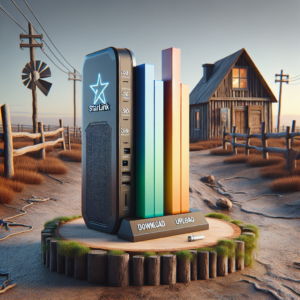
Key Takeaways
-
Starlink offers significantly higher speeds compared to Hughesnet, making it a strong contender for distance education in rural areas.
-
Hughesnet provides a more budget-friendly option with established reliability, though at lower speeds.
-
Optimal configurations for satellite internet can enhance the distance learning experience, such as using Ethernet connections and ensuring clear line of sight for dishes.
-
Latency is a crucial factor in real-time educational activities, and Starlink’s lower Earth orbit satellites offer an advantage.
-
Understanding the technical details, like data caps and equipment costs, can help users make informed decisions for their educational needs.
Rural Connectivity: Starlink and Hughesnet Put to the Test
Living in a rural area doesn’t mean settling for less—especially when it comes to internet connectivity. With the rise of distance education, having a reliable and fast internet connection is more important than ever. Let’s dive into the world of rural internet and find out how to stay connected with speed and efficiency.
Why Reliable Internet is Critical for Distance Education
Education is evolving, and the internet is now its backbone. Students and educators in rural areas need a connection that can handle video conferencing, large file downloads, and interactive online platforms without a hitch. Because without it, the quality of education suffers.
Defining Rural Internet Challenges
Getting high-speed internet in rural areas can be tough. Traditional broadband services often don’t reach these areas, leaving residents with limited options. Satellite internet has become the go-to solution, but not all satellite services are created equal.
Imagine a classroom where the teacher freezes on screen or the study material takes forever to download. That’s the challenge we’re tackling.
Bridging the Gap: Satellite Internet Options
Satellite internet has changed the game for rural connectivity. With the advent of companies like Starlink and Hughesnet, the days of slow, unreliable internet are becoming a thing of the past—for some.
Starlink’s High-Speed Revolution
Starlink, a venture by SpaceX, is shaking things up with its low Earth orbit satellites. These satellites are closer to the ground, reducing latency and boosting speeds. Starlink’s approach aims to deliver broadband-like speeds even to the most remote locations.
Hughesnet’s Established Presence
On the other hand, Hughesnet has been around for much longer and has a proven track record in providing satellite internet to rural areas. While it doesn’t boast the same high speeds as Starlink, it offers a stable and consistent service.
-
Starlink: Promises speeds of up to 150 Mbps
-
Hughesnet: Offers speeds up to 25 Mbps
These numbers might seem starkly different, but let’s break it down further and see how these services really stack up for educational purposes.
Getting the Best from Starlink
To harness the full potential of Starlink for distance education, you need to get your setup right. First, ensure that the satellite dish has a clear view of the sky—obstructions like trees and buildings can significantly impact your signal strength. Next, consider using a wired Ethernet connection from the Starlink modem to your computer or router. While Wi-Fi is convenient, a direct connection eliminates potential interference and provides a more stable connection for online learning.
Maximizing Hughesnet Performance
Hughesnet users can also take steps to optimize their internet experience. Similar to Starlink, a clear line of sight for the dish is crucial. Hughesnet’s ‘Bonus Zone’—a period between 2 a.m. and 8 a.m. where data usage doesn’t count against your plan—can be a strategic time for downloading large files or updating software without eating into your data allowance. Additionally, prioritizing your data usage can help manage the lower speeds; schedule high-bandwidth activities like video streaming during off-peak hours to avoid congestion.
Head-to-Head: Speed and Reliability Showdown
When comparing Starlink and Hughesnet, we’re looking at two different approaches to satellite internet. Starlink’s network is designed for speed, leveraging a constellation of satellites in low Earth orbit. Hughesnet, while slower, has a longstanding presence in the market, known for its reliability. For rural students and educators, the choice between speed and reliability can be pivotal.
Connection Speed Analysis
Connection speed is more than just a number—it’s the difference between a smooth, uninterrupted learning session and a frustrating, disjointed one. Starlink’s advertised speeds of up to 150 Mbps far outpace Hughesnet’s 25 Mbps. But remember, these are maximum speeds, and real-world performance can vary due to factors like weather, satellite positioning, and network congestion.
Uptime and Reliability Assessment
While Starlink may offer faster speeds, Hughesnet has built a reputation for consistent service. Uptime—the measure of system reliability—is critical, especially during live classes and exams. Hughesnet’s geostationary satellites provide a stable connection, which is less susceptible to the dips in service that can affect Starlink’s more complex network of moving satellites.
However, Starlink is rapidly expanding and improving its network, which may lead to increased reliability over time. As of now, users report varying experiences, with some enjoying near-perfect uptime and others facing occasional interruptions.
Streamlining Your Distance Learning Experience
Whether you’re using Starlink or Hughesnet, streamlining your internet setup can vastly improve your distance learning experience. This involves optimizing your network for the unique demands of online education.
Adjusting for Streaming and Video Conferencing
For live video lessons, a stable connection is non-negotiable. Reducing the number of devices connected to your network during these times can help prevent bandwidth bottlenecks. If your service has data limits, like Hughesnet, consider lowering video quality settings to conserve data while maintaining a smooth stream.
For Starlink users, taking advantage of the system’s higher speeds means you can often enjoy higher-quality video without as much worry about data usage—though it’s always wise to keep an eye on your consumption.
Best Practices for Continuous Learning
Consistency is key in distance education. To maintain a continuous learning experience, schedule regular internet downtimes for system updates and backups during hours when you’re not in class. Additionally, keep backup offline materials handy in case of unexpected internet outages, so your learning doesn’t have to stop.
Most importantly, stay informed about your satellite internet provider’s maintenance schedules and updates, as these can affect your connection’s stability.
The Ultimate Showdown: Starlink vs Hughesnet
Choosing between Starlink and Hughesnet for distance education comes down to your specific needs and circumstances. Here’s a quick rundown:
-
Starlink: Best for users who need high speeds for interactive, bandwidth-intensive tasks.
-
Hughesnet: Ideal for users who prioritize budget and reliability over high-speed performance.
Remember, satellite internet is an evolving technology, and both providers are continually improving their services. Keeping up with the latest developments will help you make the best choice for your educational needs.
Download and Upload Speed Faceoff
When it comes to download and upload speeds, Starlink currently leads the race. This advantage is crucial for students downloading large files or uploading assignments. Hughesnet’s speeds are more modest, but for general browsing and less data-intensive tasks, it’s often sufficient.
Latency Comparison for Real-time Education
Latency—often referred to as ‘ping’—is the time it takes for data to travel from your device to the server and back. Lower latency is vital for real-time interactions like video calls. Starlink’s low Earth orbit satellites generally offer lower latency compared to Hughesnet’s geostationary satellites, which can make a noticeable difference in the fluidity of online discussions and collaborations.
With these insights, you’re now better equipped to navigate the rural internet landscape and select the service that best fits your distance education needs. Always remember to balance speed, reliability, and cost to find the most suitable solution for you.
Recommendations for Rural Institutions
Rural institutions, such as schools and libraries, play a pivotal role in providing access to distance education. It’s essential for these institutions to select an internet service that not only meets their budget but also provides the necessary speed and reliability for students and educators. Investing in a robust network infrastructure, including commercial-grade routers and backup power solutions, can help ensure that internet access remains consistent and dependable.
Frequently Asked Questions
How do weather conditions affect satellite internet like Starlink and Hughesnet?
Weather conditions can impact satellite internet services, but to varying degrees. Heavy rain, snow, or dense cloud cover can cause temporary disruptions or signal degradation, known as rain fade. Starlink, with its low Earth orbit satellites, is designed to minimize weather-related issues, but no service is completely immune. Hughesnet, with its higher orbit, may be more susceptible to such disruptions. It’s always a good idea to have a backup plan for critical online activities during adverse weather conditions.
Can I use my own router with Starlink or Hughesnet for distance education?
Yes, you can use your own router with both Starlink and Hughesnet. However, it’s important to ensure that your router is compatible and can handle the speeds provided by your satellite internet service. A high-quality router can improve your overall network performance, which is crucial for a seamless distance education experience.
For the best results, consult your internet provider’s guidelines on compatible routers and consider routers with QoS (Quality of Service) settings to prioritize educational traffic.
What are data caps and how do they influence distance learning using Starlink or Hughesnet?
Data caps are limits imposed by an internet service provider on the amount of data you can use within a billing cycle. Exceeding these limits can result in additional charges or reduced internet speeds. Hughesnet has data caps, which means that heavy usage, such as downloading large video files for classes, could be restricted. Starlink currently offers unlimited data, giving users more freedom for data-intensive tasks without worrying about overage fees or throttled speeds.
Is there a difference in the installation process between Starlink and Hughesnet?
The installation process for Starlink and Hughesnet differs. Starlink’s user-friendly design allows for a relatively simple self-installation process. In contrast, Hughesnet typically requires professional installation to align the dish with the geostationary satellite accurately. Understanding the installation requirements and associated costs can help you prepare for setting up your satellite internet service.
What should I do if my satellite internet connection is frequently interrupted during lessons?
If you’re experiencing frequent interruptions during online lessons, here are a few steps to troubleshoot the issue:
-
Check for any obstructions blocking the satellite dish’s line of sight.
-
Restart your modem and router to refresh your internet connection.
-
Contact your internet service provider to report the issue and seek technical support.
-
Consider scheduling classes during times when the network is less congested.
Consistent interruptions can severely impact the quality of distance education, so it’s crucial to address these issues promptly.







